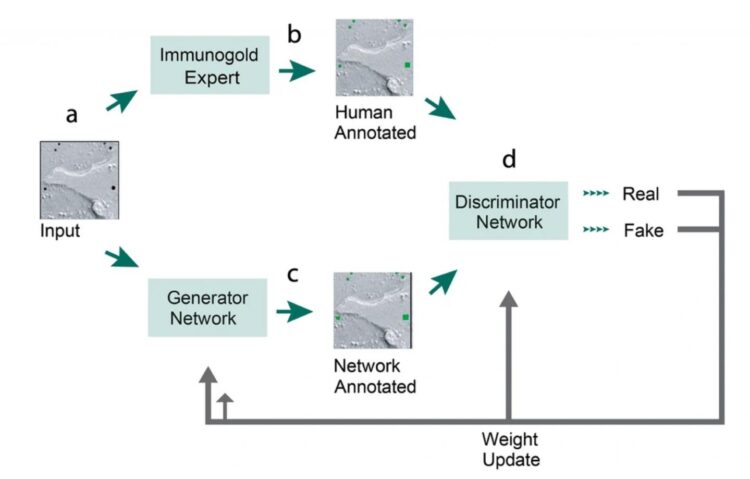Researchers at the Max Planck Florida Institute for Neuroscience used machine learning to develop a new, fully automated way to search and identify gold particles markers in electron micrographs with near human-level accuracy

Credit: Max Planck Florida Institute for Neuroscience
From sample preparation to image acquisition, electron microscopy (EM) requires precise and time-consuming steps to produce the clarity and detail needed to visualize small cell structures with high resolution. Moreover, once EM images are created, extracting the biological information out of them through analysis can be an even more laborious and time intensive task. Especially because current EM analysis software often requires the skilled eye of a scientist to manually review hundreds of images.
With a bit of ingenuity and the application of cutting-edge neural networks, an interdisciplinary team of scientists at the Max Planck Florida Institute for Neuroscience (MPFI) have created a new powerful analysis software aimed at streamlining part of the lengthy process. In collaboration with the Electron Microscopy Core Facility and the Christie Lab, the project tasked two high school students with dramatically improving upon established computer-based techniques for the analysis of protein distribution in EM images. Unlike traditional light microscopy that uses fluorescent labeling, EM requires proteins to be labeled with gold nanoparticles in order to visualize them within a cell. Playfully named “Gold Digger”, the software uses a deep learning approach to identify gold particles bound to specific proteins of interest.
In their new publication in Scientific Reports, the MPFI team has engineered an adaptable, deep learning-based algorithm capable of accurately identifying different sizes of gold particles. This fully automated approach will speed up the counting process and generate more precise location information of protein distributions across a membrane, expediting new breakthroughs.
Deep learning or neural networks is a computational strategy that allows software to progressively learn over time. Much like the human brain, these types of algorithms are able to deconstruct a visual scene into individual components and be taught to recognize certain aspects. By supplying pre-annotated “training data” the software learns how to copy and mimic human actions for a given task, something that computers weren’t able to do in the not-so-distant past.
“One of the challenges of the project, was figuring out a way to train our software to recognize only gold particles which appear dark on an electron micrograph, as opposed similarly looking shadows caused by the uneven surface of a cell; something that only trained EM experts could do previously” explains Dr. Michael Smirnov, Neural Data Scientist at MPFI and corresponding author of the publication. “We found that by feeding enough training data and correcting errors that pop up in our algorithms, our software could distinguish gold particles from these shadow artifacts with near human level accuracy. I think this really demonstrates the robustness and utility of our technique.”
This project started with the curiosity of two high school data science students, Diego Jerez and Eleanor Stuart, but quickly it developed into a more complex and interdisciplinary project. “I feel very lucky to get the unique opportunity to apply what we’ve learned in the classroom setting to real world scientific pursuit, and seeing first-hand how data science can help address scientific questions,” explained Diego Jerez, first author of this publication. “These young students showed a real aptitude for this type of coding and conceptual work and I couldn’t be more proud of what they have accomplished. I can’t wait to see the contributions they’ll make to the scientific community in the future,” describes Dr. Smirnov.
The small, compact architecture of the Gold Digger software was primarily used for freeze fracture replica EM, but it was specifically designed to be generalizable and compatible between various EM applications including changes in magnification, image area, cell type and gold particle size. The software will soon be distributed open source and include a user-friendly interface. Scientists everywhere will have the opportunity to take full advantage of and improve upon this innovative algorithm.
“The synergy of the collaborative work of our team was crucial to bridge the gap between these areas of expertise” explained Naomi Kamasawa, Ph.D., the Head of the Electron Microscopy Core Facility at MPFI. “But this is what the Max Planck Society does – bring together people who are passionately curious about a variety of subjects, and allow them to be creative together. When you do that, anything is possible.”
###
Media Contact
Helena Decker
[email protected]
Original Source
https:/
Related Journal Article
http://dx.





